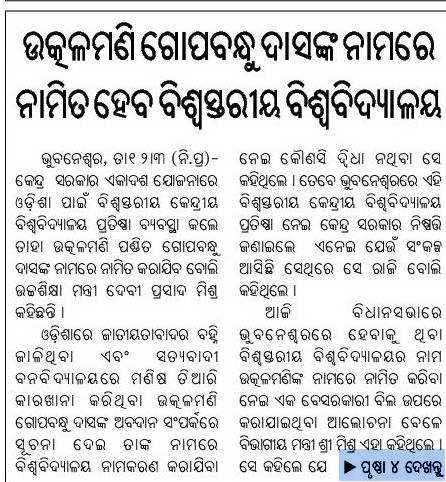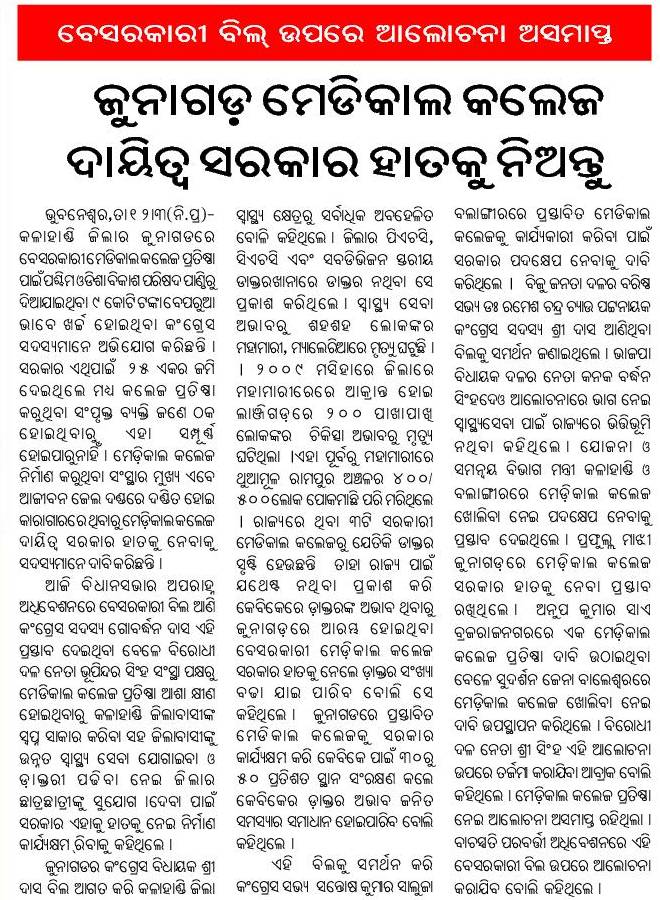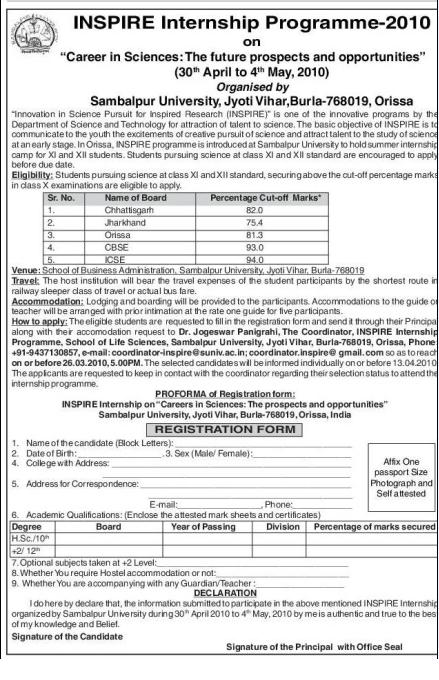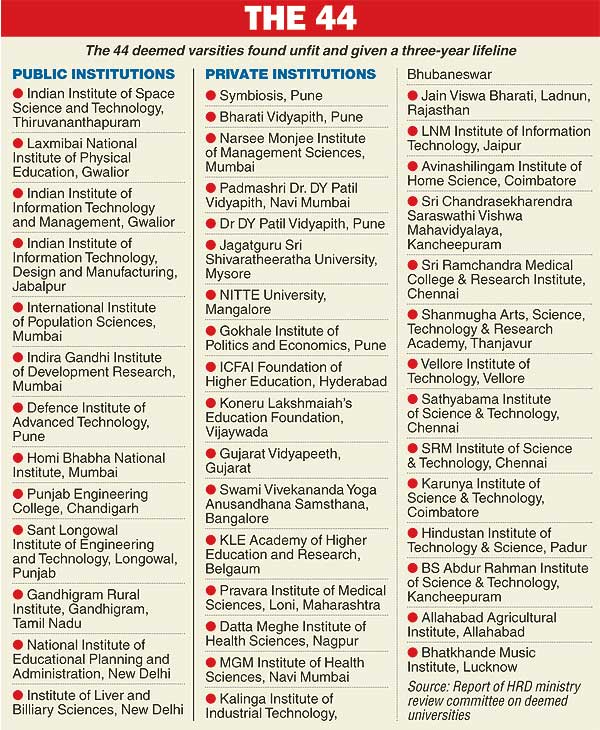Number of seats in various colleges of OUAT (Orissa University of Agricultute and Technology): from Samaja
1 comment April 4th, 2010
1 comment April 4th, 2010
I fully agree with this article by David Finegold in Indian Express. Following are some excerpts.
… Unfortunately, the proposed legislation to encourage the leading universities from around the world to set up campuses in India is unlikely to achieve the desired objectives. Below are 10 reasons why these top universities are not likely to come in the numbers projected, one possible exception to this scenario, and a suggested alternative approach to reform that could meet the desired objective more quickly.
… The timing of the bill could not have been worse for encouraging the world’s best universities to invest in creating new campuses.
… When Sibal toured the US in the fall of 2009 to recruit the leading private universities, part of his pitch was they should follow the lead of IT and business service multinationals and come to India because it offers a source of high-quality, low-cost talent. The problem with this analogy is that leading universities are not driven by a desire to lower labour costs or increase profits; … Rather, India should appeal to their desire to attract the world’s most able students,
…The bill likewise misunderstands the motives of many of the Indian students now travelling abroad to obtain their degrees. … This ignores the reality that, even with the huge growth in opportunities in the Indian economy, an equal or greater part of students’ motivation for studying abroad is the chance to get a job in that country after graduation.
… With a few notable exceptions — e.g. Wharton’s decision to create a small campus in Silicon Valley, the recent forays into Dubai and Singapore — most of the universities that India is seeking to recruit have resisted the temptation to grow for centuries, …
… As a subset of these universities looks to establish foreign campuses, they are likely to be most attracted to those countries which offer them generous incentives that both reduce upfront costs and the risks associated with global expansion. … India is not proposing any such financial inducements.
… those who opt for a PhD and are able to publish in the top academic journals in their field — the talent pool that would interest leading foreign universities — are in demand in a global labour market that enables them to work anywhere in the world. Attracting them or their peers from other countries to campuses in India would mean paying competitive salaries that would erase India’s cost advantage.
… The combined effect of the above factors is that those institutions which are most likely to be attracted to the Indian market are those that the Indian government least wants: the lower-quality providers that treat higher education as a way to make money, rather than focusing on world-class research and the quality of the learning experience.
... One attractive option for a few of the leading foreign universities might be the endowment of an Indian campus by a wealthy individual (perhaps one of their alumni) and/or corporation. This was the way in which many of India’s most respected private higher education institutions were first created — i.e. the Tata Institutes in different disciplines and The Indian School of Business — and how many of the leading private US universities (Stanford, Carnegie Mellon, University of Chicago, Duke) came into being. A key element that enabled these institutions to become and remain world-class, however, was that the founding individual/family gave the resources with relatively few strings attached, and allowed the university to govern itself, rather than the much more hands-on approach of many of the universities created more recently by Indian industrialists.
… However, an alternative strategy is already working. It promises to expand the quality and quantity of Indian higher education and provide greater benefits to the foreign universities. This strategy encourages the formation of more dual- or joint-degree partnerships between Indian and foreign institutions.
The writer is dean of the School of Management and Labor Relations at Rutgers University. He and colleagues are conducting research for a book on “Developing the Skills of the 21st Century Workforce: Comparing the Education and Training Systems of India and China.”
The part in red is close to (but not 100%) what Vedanta University seems to be about. Unfortunately many in Odisha do not understand it.
The underlined part is already happening. One major instances is the partnership between Asian Institute of Public Health in Bhubaneswar and University of Maryland Medical school in Baltimore.
3 comments April 2nd, 2010
The following was posted in youtube 3 weeks back.
The following is 10 months old and about the status of construction then.
March 31st, 2010
Update2: Excerpts from Expressbuzz.
An MoU was signed between Ravenshaw University Vice- Chancellor Devdas Chotray and AIPH founder secretary Dr Pinaki Panigrahi for the launch of the Masters in Public Health (MPH) programme. Besides imparting comprehensive skills in public health, the course would turn students into experts on occupational and environmental health, public health informatics and clinical and behavioural sciences. With an extensive hands-on experience, they will pass out as professionals ready to shoulder the challenges of the rise of chronic, infectious, occupational and environmental health problems that are vital contributors to high infant and maternal mortality in the State.
The first of its kind programme in Orissa is accreditated by the Council of Education on Public Health (CEPH) under the USA Government. The students would also gain credit points that would facilitate pursuance of higher studies in the US if they so willed.
But, foremost, the programme would churn out the much needed manpower in the State. There are at least 10,000 jobs for public health professionals in the district and block level under the National Rural health Mission. This apart, public health professionals are much sought after by private health sector enterprises, national and international agencies.
Update: Dharitri’s take on this.
The Asian Institute of Public Health in Bhubaneswar has announced a PG Diploma program in Public Health Informatics. This course will start in September 2010. Some details on the course obtained from their page http://www.aiph.ac.in/academics.html is as follows:
Post Graduate Diploma in Public Health Informatics (24 Credits, 12 months course begins 1st September, 2010)
The objective of this course is to help individuals gain knowledge and skills in informatics concepts and applications and advance the use of informatics in risk assessment, disease monitoring and disease surveillance. The course provides an opportunity for the students to understand the information system architecture in public health, privacy, confidentiality and security issues related to health information systems. Graduate students from all disciplines are eligible for this course that will be offered online three times a year. The course consists of the following modules:
· Introduction to Public Health Informatics (IPHI) – Basics of public health informatics, core competencies of public health professionals, and systematic review of public health information systems.
· Foundation of Health Information Systems (FHIS) – This course is designed to help individuals gain knowledge and skills in public health standards, databases, privacy, confidentiality and security issues relevant to public health information systems.
· Applications of Public Health Informatics (APHI) – overview of clinical decision support systems, Geographic Information Systems, public health surveillance systems.
· Computer mediated Health Education and Health Promotion (CMHEHP) – Web based approaches to health education and health promotion, role of health literacy and varied learning needs of public health consumers and different stakeholders.
· A 12 credit informatics research project will be required to get the Post Graduate Diploma in Public Health Informatics.
The institute seems to have a strong faculty. See http://www.aiph.ac.in/Indian.html.
Surendra K. Mishra, MSc, PGDA, DCS
Health systems, behavioural sciences research and communication, reproductive health
Ashish Joshi, MD, MPH
Public health informatics, health outcomes research, design of multi-component interventions
Niharika Khanna, MD, DCH
HPV epidemiology, cervical cancer, cancer vaccinesPrasanna Nair, MD, MPH
Maternal and child health, epidemiology, HIV/AIDS
P N Padmanabhan, PhD, FAAASc
Nutrition, non-invasive methods for monitoring gastrointestinal health, cancer prevention
Seba Mohapatra, MD
Maternal health, health systems
Pinaki Panigrahi, MD, PhD
Epidemiology, field surveillance, human research protection, clinical trialsP. K. Senapati, MD
Health systems, health care delivery and administration
S. Ramanathan, MPhil
Health economics and finance, reproductive health, gender and equity
Preethy Nayar, MBBS, MPhil, PhD
Health services research & administration, program and policy evaluation
Shireen Rajaram, PhD
Social and behavioral sciences, access to health care, health care disparity
Pritish Nanda, PGDHM, MPH
Health communication, hospital management, social mobilization, program managementE. Venkata Rao, MD
Epidemiology, financial management
Patrik Johansson, MD, MPH.
Health communication, community-based participatory research
Ayman El-Mohandes, MD, MPH
International health, program evaluationJ. Glenn Morris Jr, MD, MPH&TM
Infectious diseases, Cholera, emerging and re-emerging diseases
Ira H. Gewolb, MD
Newborn health, biostatisticsJudith A. Johnson, PhD
Infectious diseases, antibiotic resistance, clinical microbiologyMagda G. Peck, ScD
Leadership development and practice, childhood well being evaluation
Chandran Achutan, PhD
Occupational and environmental health
Hala Azzam, PhD, MPH
Workforce development and training, field assessments, HIV/AIDS
Hrishikesh Chakraborty, DrPH
Biostatistics, epidemiology, cluster randomized trials
James Sherry, MD,PhD
Health policy, international healthJaime Gofin, MD, PhD
Program evaluation, community-oriented primary careLi-Wu Chen, MHSA, PhD
Health economics, cost-effectiveness analysis, health care utilization by underserved population
KM Monirul Islam, MBBS, PhD
Epidemiology, international health, development of surveillance system and evaluation
Ge Lin, PhD
GIS and spatial statistics, statistic methods for defining and quantifying their spatial signals
This instiute will add to the public health offerings in India which include various IIPH offerings such as:
The IIPH in Bhubaneswar (different from the AIPH) is also scheduled to start in July 2010. The AIPH and IIPH in Bhubaneswar will make Bhubaneswar a strong public health education destination. I hope both will spread their wings across Odisha so that some of the current public health issues of interior Odisha are adequately addressed. I am told AIPH is already doing that and has research projects involving interior and tribal Odisha.
Pioneer reports today that AIPH has signed an MOU with Ravenshaw University. This is a great partnership and beneficial to both.
5 comments March 27th, 2010
Following is an excerpt from a report in Business Standard.
… An official confirmed the ministry met these institutes almost two weeks ago to discuss these plans.
Yale’s talks with the HRD ministry involve mentoring all 14 universities through its leadership programme. Since none of these universities have been built, the Ivy League university’s role is to act as consultant and conceptualiser,
“Minister Sibal has agreed to work with us on the new innovation universities for references and conceptualising. We will be developing leadership programmes for the deans and vice chancellors of these universities,” George Joseph, assistant secretary, Yale University, told Business Standard.
“We don’t plan to set up an India campus anytime soon … but we would like to mentor the new innovation universities just like the Indian Institutes of Technology were mentored when they were established,” he added.
Each “innovation university” is expected to focus on one area or problem of significance to India, such as urbanisation, environmental sustainability and public health.
MIT has expressed interest in mentoring one university that is focused on the energy sector. …
Meanwhile, Yale also plans to use part of the funds from its Yale India initiative for the leadership programme for these new universities. The initiative began in November 2008 and now has almost $75 million (Rs 338 crore).
March 22nd, 2010
UCE Burla becoming VSSUT and the hiring of dynamic vice Chancellors at VSSUT (Prof. D K Tripathy from IIT Kharagpur) as well as at Sambalpur University (Prof. Arun Pujari from the University of Hyderabad) has given a huge momentum in making the Sambalpur area a knowledge hub and together with similar progress at Rourkela a western knowledge corridor is now in the making. In this write-up we will focus on the greater Sambalpur area ranging from Bargarh in the west of Sambalpur to Jharsuguda and Sundergarh in the north and north east.
The above gives the current status of this area. In addition to the efforts mentioned above, following should also be pursued.
NOTE on Comments: Only constructive comments will be allowed. Please do not submit comments that advocate separatism, conspiracy theories, shifting, badmouthing, etc.
March 14th, 2010
Tathya.in reports that this time nice debates are going on in the Odisha assembly.Following are some Samaja reports on debates relevant to education.



March 14th, 2010

Kudos to the people at Sambalpur University (The VC and the others) for organizing this program. After this they should pursue the establishment of a UM-DAE CBS (Center for Excellence in Basic Sciences) type of institute associated with Sambalpur University. The current VC has the vision and ability to make it happen. Note that the VC has initiated and obtained approval and promise for funding for a IIIT type of institute at Sambalpur University and he is also pursuing a sports institute at Sambalpur University. Having these institutes will pave the way for Sambalpur University to become an elite university in the country. In this regard, there is a recent proposal to create an IVY-league type of elite league of central universities in India. Following is an excerpt from a report in Times of India on that.
An Ivy League similar to the ones in countries like US and Germany comprising topmost universities of the country will be formed within two years, announced Kapil Sibal, Union human resource development minister here on Saturday.
… Addressing the media after the VCs’ meet, Sibal said the universities in the Ivy League will be given complete autonomy without any government control in developing the staff, faculty, students and research and development.
… Sibal said that central universities will be allowed to decide on their faculty and staff strength from the coming academic year. “Based on their budgetary allocations, the universities will be allowed to decide the number of faculty positions they need,” he said.
He also said that credit transfer system will be in place from the coming academic year so that the students from one university will be allowed to attend the courses of other universities.
1 comment March 14th, 2010
Item 69 of the MHRD Department of Higher Education budget has 15 crores for IIEST. The explanation later says the following:
69. Setting up of Indian institute of Engineering, Science & Technology (IIEST): A State University, namely, Bengal Engineering and Science University, Shibpur is proposed to be converted into a Central Government Institute, namely, Indian Institute of Engineering Science and Technology (IIEST).
Odisha must continue to push the conversion of VSSUT Burla to an IIEST.
11 comments February 26th, 2010
Following is an excerpt from a report in Pioneer.
… Since both large and medium scale industries are coming in good numbers all over the State and particularly surrounding this technical university, more job-oriented courses will be opened soon to create employment avenues for the students. The new courses will be water resources management, industrial power control and electric drives, material technology, manufacturing system engineering etc, informed Tripathy.
He also informed that all the vacancies in teaching and non-teaching posts would be filled up soon to convert this age-old institution to a full-fledged university.
… Tripathy informed that efforts are being made to give the entire campus a total new look by naming the campus as ‘Siddhi Vihar’ and the hostels after the Saptarshi Mandal.
… students of the university have stood first in the Robotic event at IIT Kharagpur recently. At the same time, it had successfully organised Samavesh-2010 with 2500 engineering students belonging to different engineering colleges all over the State. “There is possibility of getting Rs.10-20 crore aid from the World Bank for research activities,” Swain informed.
2 comments February 19th, 2010
Following is an excerpt from a report in Pioneer.
Prof. Amiya Kumar Pattanayak has been appointed as the new vice-chancellor of the Utkal University of Culture. …
Born in 1949, Prof Pattanayak started his academic journey in 1972. He holds a Ph.D in history and was professor in Berhampur University during 1994-2008. He was Registrar of Berhampur University, served as a warden, was also the Director of Distant Education Centre, Director of College Developmental Council and Director’s Women Studies Research Centre.
Prof Pattanayak has written six books, edited 12 books, has sixty-five research publications. 15 scholars have been awarded Ph.D under his guidance. Nine are continuing research under him at present. He has produced 37 M.Phil. scholars.
3 comments February 16th, 2010
Thanks to Rahul Barik for the pointer. The Telgraph article is at http://telegraphindia.com/1100214/jsp/nation/story_12104169.jsp. Following is the graphics from that web site.

1 comment February 14th, 2010
Update: Following is from Samaja.

Following is from a report in Pioneer.
The State Government has decided to set up a technical university in Sambalpur. This university would be christened as Sambalpur University Institute of Information Technology. The State Government has provided Rs 10 crore for this institute.
The Pioneer news above is a bit inaccurate. As far as I know it will be a part of Sambalpur University. The idea was mooted by Sambalpur University VC (who was earlier a Computer Science professor at University of Hyderabad) Prof. Arun Pujari. I have seen part of the proposal. Prof. Pujari had a very good proposal. His proposal and persistent efforts to get it approved finally got enthusiastic support from the IT Secretary Mr. Pradipta Mahaptra, the RDC and the Additional Chief Secretary Mr. S. P. Nanda and higher education officials (HE Secretary Mr. M. Padhi and others) and ministry. Kudos to all of them.
With the establishment of this Odisha will soon have three IIIT type institutes in Bhubaneswar, Berhampur and Sambalpur.
Special thanks to Prof. Arun Pujari. He has several other innovative plans for Sambalpur University. He has also made some very good hires in the Science disciplines at Sambalpur University. If he continues at the current rate he will be remembered as one of the best VCs of Sambalpur University. Lets support his innovative initiatives with all our heart.
17 comments February 11th, 2010
Following is an excerpt from his speech transcript in Business Standard.
It is in this dreary world of higher education in India that we have shining examples, such as St Xavier’s College. It was founded by the Society of Jesus. Long before Shri Maulana Abul Kalam Azad, Dr S Radhakrishnan, Dr Zakir Hussain, Dr Humayun Kabir and my good friend Shri Kapil Sibal, there was an intrepid soul named Fr H Depelchin. Along with six Belgian Jesuits, he arrived in Kolkata and founded the St Xavier’s College.
The college has been in the service of the nation for 150 years. Not only in Kolkata, but in many other parts of India, the Society of Jesus has rendered yeoman service to the cause of education. Its 153 high schools, 38 university colleges, 14 technical institutes and five business administration institutes teach, at any given time, over 230,000 students belonging to every section of the society. St Xavier’s alone has over 4,000 students.
Like every Jesuit educational institution, St Xavier’s College has an admission policy that is biased in favour of the poor, especially the socially and financially marginalised, and I commend the college on its sense of social responsibility. We are beholden to the Jesuits for the unwavering dedication, the sense of duty, and the strict discipline they bring to their work and to the institutions founded by them.
I passed through a Jesuit institution and I fondly remember the great teachers: Fr Murphy, Fr Sequira, Fr Coyle, Fr Lawrence Sundaram, Fr Amascua and Fr Yedanapally. It surprises me even today how so many of them could leave such an indelible impression in a period of barely one year.
We are still debating the norms and values that must prevail in an institution of higher learning, and especially the place of the non-government sector in providing higher education. I recognise and support the role of the private sector in higher education, but I am absolutely clear in my mind that the private sector in higher education ought not to mean private business in higher education. As far as I am aware, no great university in the world was established for the purpose of profit. I believe that some activities in a society must stand outside the world of profit and higher education, in my view, ranks first amongst such activities.
For over 150 years, the Society of Jesus has done just that in Kolkata, in Chennai and in many other towns and cities. For that and for many other blessings that they brought to India, we thank them and we salute them.
(Excerpts from Home Minister P Chidambaram‘s valedictory address at St Xavier’s College (Autonomous) in Kolkata on January 17, 2010)
The above is very relevant to the proposal of a Xavier University in Odisha. The Odisha government should expedite that proposal.
3 comments February 7th, 2010
Following is an excerpt from a report in Expressbuzz.com.
The Central University here will soon set up a medical college and hospital in Koraput. Vice-Chancellor Surobhi Benerjee announced this in a release today.
The university is now in the process of submitting the detailed project report (DPR) to the appropriate authorities.
She also said there would be a detailed discussion with Chief Minister Naveen Patnaik in this regard tomorrow.
Moreover, the university is going to start a school for bio-diversity and conservation of natural resources in collaboration with M.S. Swaminathan Research Foundation (MSSRF), Chennai.The authorities of the MSSRF have agreed to provide all support in establishing the school and run collaborative PG programmes. …
COMMUNITY RADIO: Besides, the university will set up a community radio station in Koraput for the development of the tribal community. A proposal for commissioning the radio station had been submitted to the Ministry of Information and Broadcasting. The university is also going to set up a centre for community welfare in Koraput.
SCHOOL OF HEALTH SCIENCE: Further, the university will sign an MoU with Jamia Hamdard University, New Delhi, in the area of nursing and public/ community health for its proposed school of health science (Nursing, public health and community health).
2 comments February 2nd, 2010
Following are excerpts from a report in Times of India.
In its revised concept note on the setting up of 14 Innovation Universities, the HRD ministry has proposed two types of reservation policy for these institutions, some of which will be directly funded by the government while a few will be in the PPP mode.
Within PPP, it has been proposed that world class universities from abroad might also be invited to set up similar such institutes here. The government will be a partner in the establishment and research programme while the cost of teaching will be funded by the promoter university.
The Innovation Universities fully-funded by the government will follow the existing reservation policy in admission for SCs/STs/OBCs. The Central Educational Institutions (Reservation in Admission) Act, 2006, will be applicable in their case.
However, in case of Innovation Universities in PPP mode, the HRD note says affirmative action cannot be wished away. Therefore, it has been suggested to weight the test scores with a measure for the socio-economic background of the candidates. …
There has also been a slight modification about auditing of accounts. While the money spent by a university or faculty on research or teaching will be kept out of the purview of Comptroller and Auditor General, the expenditure on administration or non-academic areas will be audited by CAG.
Two modes of establishment of Innovation Universities have also been decided. While those fully-funded by the government will come up through an Act of Parliament, the ones through PPP will be established through a Memorandum of Understanding. Financial, academic and research credentials of the private promoter will be the main criterion in selecting them to collaborate with the government.
The Innovation Universities will also have the freedom to decide on their own admission policy.
The 14 Innovation Universities will come up in Amritsar, Greater Noida, Jaipur, Patna, Guwahati, Kolkata, Bhopal, Kochi, Gandhinagar, Coimbatore, Mysore, Pune, Vishakhapatnam, Bhubaneswar.
January 30th, 2010
| M | T | W | T | F | S | S |
|---|---|---|---|---|---|---|
| 1 | 2 | 3 | ||||
| 4 | 5 | 6 | 7 | 8 | 9 | 10 |
| 11 | 12 | 13 | 14 | 15 | 16 | 17 |
| 18 | 19 | 20 | 21 | 22 | 23 | 24 |
| 25 | 26 | 27 | 28 | 29 | 30 | |